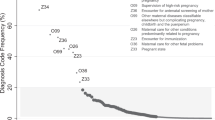Abstract
Objective
To improve upon the accuracy of ICD codes for identifying maternal and neonatal outcomes by developing algorithms that incorporate readily available EHR data.
Study design
Algorithms were developed for gestational hypertension (GHTN), pre-eclampsia (PreE), gestational diabetes mellitus (GDM) and were compared to ICD codes and chart review. Accuracy and sensitivity analyses were calculated with their respective 95% confidence limits for each of the comparisons between algorithms, ICD codes alone, and chart review.
Results
Sensitivity of GHTN ICD codes was 8.1% vs. 83.8% for the algorithm when compared to chart review. In comparison to chart review, sensitivity of ICD codes for PreE was 7.5% vs. 71.4% for the algorithm. GDM had similar sensitivity rates for both ICD codes and the algorithm.
Conclusion
Application of algorithms, validated by chart review, enhanced capture of several outcomes. Algorithms should be obligatory adjunct tools to the ICD codes for identification of outcomes of interest.
This is a preview of subscription content, access via your institution
Access options
Subscribe to this journal
Receive 12 print issues and online access
$259.00 per year
only $21.58 per issue
Buy this article
- Purchase on Springer Link
- Instant access to full article PDF
Prices may be subject to local taxes which are calculated during checkout
Similar content being viewed by others
Data availability
Data are available are upon reasonable request. Deidentified data are available from Geisinger upon completion of legal and ethical processes.
References
World Health Organization (WHO). World Health Organization Obesity: preventing and managing the global epidemic. Report of a WHO consultation WHO Technical Report Series, 894. 2000.
Baeten JM, Bukusi EA, Lambe M. Pregnancy complications and outcomes among overweight and obese nulliparous women. Am J Public Health. 2001;91:436–40.
Bhattacharya S, Campbell DM, Liston WA, Bhattacharya S. Effect of body mass index on pregnancy outcomes in nulliparous women delivering singleton babies. BMC Public Health. 2007;7:168.
Davies GAL, Maxwell C, McLeod L, Maternal Fetal Medicine Committee, Clinical Practice Obstetrics. Obesity in pregnancy. J Obstet Gynaecol Can. 2010;32:165–73.
Deruelle P, Servan-Schreiber E, Riviere O, Garabedian C, Vendittelli F. Does a body mass index greater than 25kg/m2 increase maternal and neonatal morbidity? A french historical cohort study. J Gynecol Obstet Hum Reprod. 2017;46:601–8.
Goldstein RF, Abell SK, Ranasinha S, Misso M, Boyle JA, Black MH, et al. Association of Gestational Weight Gain With Maternal and Infant Outcomes: A Systematic Review and Meta-analysis. JAMA 2017;317:2207–25.
O’malley KJ, Cook KF, Price MD, Wildes KR, Hurdle JF, Ashton CM. Measuring diagnoses: ICD code accuracy. Health Serv Res. 2005;40:1620–39.
Sigakis MJ, Leffert LR, Mirzakhani H, Sharawi N, Rajala B, Callaghan WM, et al. The Validity of Discharge Billing Codes Reflecting Severe Maternal Morbidity. Anesth Analg. 2016;123:731–8.
Committee on Practice Bulletins—Obstetrics. ACOG Practice Bulletin No. 202: gestational hypertension and preeclampsia. Obstet Gynecol, 2019:133;e1–e25.
Bulletins-Obstetrics, C.. ACOG practice bulletin no. 190: gestational diabetes mellitus. Obstet Gynecol, 2018;131:e49–e64.
Olsen IE, Groveman SA, Lawson ML, Clark RH, Zemel BS. New intrauterine growth curves based on united states data. Pediatrics 2010;125:e214–24.
Vassar M, Holzmann M. The retrospective chart review: important methodological considerations. J Educ Eval Health Prof. 2013;10:12.
Wall-Wieler E, Abrams B, Snowden JM, Carmichael SL. Defining maternal obesity in studies of birth outcomes: Comparing ICD-9 codes at delivery and measures on the birth certificate. Paediatr Perinat Epidemiol. 2020;34:618–27.
Scheid LM, Brown LS, Clark C, Rosenfeld CR. Data electronically extracted from the electronic health record require validation. J Perinatol. 2019;39:468–74.
Gearing RE, Mian IA, Barber J, Ickowicz A. A methodology for conducting retrospective chart review research in child and adolescent psychiatry. J Can Acad Child Adolesc Psychiatry. 2006;15:126–34.
Funding
The research was supported and funded by Geisinger Clinic.
Author information
Authors and Affiliations
Contributions
The study idea was created by ADM and KA. The protocol was drafted by KA and edited by ADM and MJP. Data collection was performed by CG and edited by all authors. Chart review was completed by VB and KA. AY performed statistical analysis. Paper was prepared by KA and edited and approved by all authors.
Corresponding author
Ethics declarations
Competing interests
Neither the study team nor any of its family members received specific grant from any funding agency in the public, commercial or not-for-profit sectors. The authors report no competing interests.
Ethics approval
This study was approved by the Geisinger IRB. IRB#2017-0520. Meets exemption under 45 CFR 46.104, where the research involves only information collection and analysis from health information for research purposes.
Additional information
Publisher’s note Springer Nature remains neutral with regard to jurisdictional claims in published maps and institutional affiliations.
Supplementary information
Rights and permissions
Springer Nature or its licensor holds exclusive rights to this article under a publishing agreement with the author(s) or other rightsholder(s); author self-archiving of the accepted manuscript version of this article is solely governed by the terms of such publishing agreement and applicable law.
About this article
Cite this article
Angras, K., Boyd, V.E., Gray, C. et al. Retrospective application of algorithms to improve identification of pregnancy outcomes from the electronic health record. J Perinatol 43, 10–14 (2023). https://doi.org/10.1038/s41372-022-01496-1
Received:
Revised:
Accepted:
Published:
Issue Date:
DOI: https://doi.org/10.1038/s41372-022-01496-1
This article is cited by
-
Polygenic prediction of preeclampsia and gestational hypertension
Nature Medicine (2023)



